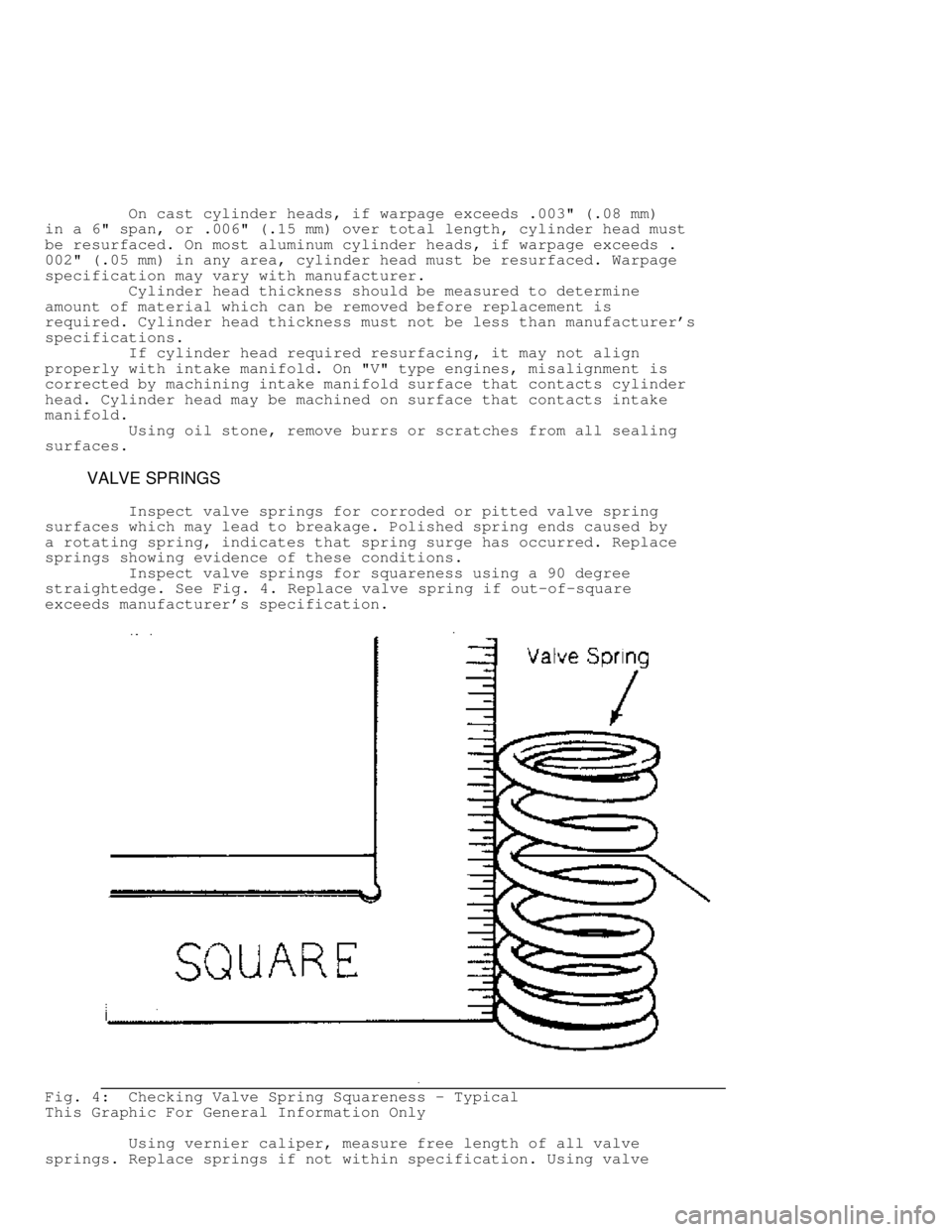1999 DODGE RAM checking oil
[x] Cancel search: checking oilPage 670 of 1691

On cast cylinder heads, if warpage exceeds .003" (.08 mm)
in a 6" span, or .006" (.15 mm) over total length, cylinder head must
be resurfaced. On most aluminum cylinder heads, if warpage exceeds .
002" (.05 mm) in any area, cylinder head must be resurfaced. Warpage
specification may vary with manufacturer.
Cylinder head thickness should be measured to determine
amount of material which can be removed before replacement is
required. Cylinder head thickness must not be less than manufacturer's
specifications.
If cylinder head required resurfacing, it may not align
properly with intake manifold. On "V" type engines, misalignment is
corrected by machining intake manifold surface that contacts cylinder
head. Cylinder head may be machined on surface that contacts intake
manifold.
Using oil stone, remove burrs or scratches from all sealing
surfaces.
VALVE SPRINGS
Inspect valve springs for corroded or pitted valve spring
surfaces which may lead to breakage. Polished spring ends caused by
a rotating spring, indicates that spring surge has occurred. Replace
springs showing evidence of these conditions.
Inspect valve springs for squareness using a 90 degree
straightedge. See Fig. 4. Replace valve spring if out-of-square
exceeds manufacturer's specification.
Fig. 4: Checking Valve Spring Squareness - Typical
This Graphic For General Information Only
Using vernier caliper, measure free length of all valve
springs. Replace springs if not within specification. Using valve
Page 692 of 1691

length of cylinder block at several points.
If warpage exceeds specifications, deck must be resurfaced.
If warpage exceeds manufacturer's maximum tolerance for material
removal, replace block.
DECK HEIGHT
Distance from the crankshaft centerline to the block
deck is termed the deck height. Measure and record front and rear main
journals of crankshaft. To compute this distance, install crankshaft
and retain with center main bearing and cap only. Measure distance
from the crankshaft journal to the block deck, parallel to the
cylinder centerline.
Add one half of the main bearing journal diameter to distance
from crankshaft journal to block deck. This dimension should be
checked at front and rear of cylinder block. Both readings should be
the same.
If difference exceeds specifications, cylinder block must be
repaired or replaced. Deck height and warpage should be corrected at
the same time.
MAIN BEARING BORE & ALIGNMENT
For checking main bearing bore, remove all bearings from
cylinder block and main bearing caps. Install main bearing caps in
original location. Tighten bolts to specification. Using inside
micrometer, measure main bearing bore in 2 areas 90 degrees apart.
Determine bore size and out-of-round. If diameter is not within
specification, block must be align-bored.
For checking alignment, place a straightedge along centerline
of main bearing saddles. Check for clearance between straightedge and
main bearing saddles. Block must be align-bored if clearance is
present.
EXPANSION PLUG REMOVAL & INSTALLATION
Removal
Drill a hole in the center of expansion plug. Remove with
screwdriver or punch. Use care not to damage sealing surface.
Installation
Ensure sealing surface is free of burrs. Coat expansion plug
with sealer. Use a wooden dowel or pipe of slightly smaller diameter,
install expansion plug. Ensure expansion plug is evenly located.
OIL GALLERY PLUG REMOVAL & INSTALLATION
Removal
Remove threaded oil gallery plugs using the appropriate
wrench. Soft, press-in plugs are removed by drilling into plug and
installing a sheet metal screw. Remove plug with slide hammer or
pliers.
Installation
Ensure threads or sealing surface is clean. Coat threaded oil
gallery plugs with sealer and install. Replacement soft press-in plugs
are driven in place with a hammer and drift.
CAMSHAFT
* PLEASE READ THIS FIRST *
Page 703 of 1691

Engine pre-oiling can be done using pressure oiler (if
available). Connect pressure oiler to cylinder block oil passage
such as oil pressure sending unit. Operate pressure oiler long enough
to ensure correct amount of oil has filled crankcase. Check oil level
while pre-oiling.
If pressure oiler is not available, disconnect ignition
system. Remove oil pressure sending unit and replace with oil pressure
test gauge. Using starter motor, rotate engine starter until gauge
shows normal oil pressure for several seconds. DO NOT crank engine
for more than 30 seconds to avoid starter motor damage.
Ensure oil pressure has reached the most distant point from
the oil pump. Reinstall oil pressure sending unit. Reconnect ignition
system.
INITIAL START-UP
Start the engine and operate engine at low speed while
checking for coolant, fuel and oil leaks. Stop engine. Recheck coolant
and oil level. Adjust if necessary.
CAMSHAFT
Break-in procedure is required when a new or reground
camshaft has been installed. Operate and maintain engine speed between
1500-2500 RPM for approximately 30 minutes. Procedure may vary due to
manufacturers recommendations.
PISTON RINGS
Piston rings require a break-in procedure to ensure seating
of rings to cylinder walls. Serious damage may occur to rings if
correct procedures are not followed.
Extremely high piston ring temperatures are produced obtained
during break-in process. If rings are exposed to excessively high RPM
or high cylinder pressures, ring damage can occur. Follow piston ring
manufacturer's recommended break-in procedure.
FINAL ADJUSTMENTS
Check or adjust ignition timing and dwell (if applicable).
Adjust valves (if necessary). Adjust carburetion or injection idle
speed and mixture. Retighten cylinder heads (if required). If
cylinder head or block is aluminum, retighten bolts when engine is
cold. Follow the engine manufacturer's recommended break-in procedure
and maintenance schedule for new engines.
NOTE: Some manufacturer's require that head bolts be retightened
after specified amount of operation. This must be done to
prevent head gasket failure.
Page 1310 of 1691

WHEEL ALIGNMENT
NOTE: See appropriate SPECIFICATIONS & PROCEDURES article in WHEEL
ALIGNMENT.
WHEEL BEARING ADJUSTMENT
1) Tighten wheel bearing adjusting nut to 30-40 ft. lbs. (41-\
54 N.m) while rotating wheel. Stop rotation, and back off adjusting
nut to release all preload. Retighten nut finger tight.
2) Ensure bearing end play is .001-.003" (.025-.076 mm).
Install nut lock and cotter pin. Coat grease cap inside lightly with
grease, and install cap.
BALL JOINT CHECKING
Ball joints are preloaded. Replace lower ball joint if
vertical movement exceeds .03" (.8 mm). Replace upper ball joint if
movement exceeds .03" (.8 mm).
REMOVAL & INSTALLATION
COIL SPRING
Removal
1) Raise vehicle, and position safety stands under frame.
Remove wheels. Remove brake caliper retainer and brake caliper (if
necessary). Support caliper aside. Disconnect tie rod from steering
knuckle.
2) Disconnect stabilizer bar link from lower control arm. See
Fig. 1 . Support lower suspension arm outboard end with jack. Place
jack under arm in front of shock mount. Remove cotter pin and nut from
lower ball joint stud. Using Ball Joint Breaker (C-4150A), separate
ball joint from steering knuckle.
3) Remove lower shock bolt from suspension arm. Lower jack
and suspension arm until spring tension is relieved. Remove spring and
rubber isolator.
Installation
1) Install rubber isolator on top of spring. Position spring
between upper spring seat and lower suspension arm. Raise suspension
arm with jack, and position shock into suspension arm mount.
2) Install shock bolt and tighten to specification. See
TORQUE SPECIFICATIONS table. Install steering knuckle on lower ball
joint stud. Install lower ball joint stud nut and tighten. See TORQUE
SPECIFICATIONS table. Replace cotter pin, and remove jack. Install
stabilizer bar link on lower suspension arm. Install grommet, retainer
and nut.
3) Install tie rod on steering knuckle, and tighten nut to 65
ft. lbs. (88 N.m). Install brake caliper assembly and rotor. Install
tire and wheel assembly. Remove support, and lower vehicle.
STEERING KNUCKLE
Removal & Installation
1) Raise and support vehicle. Remove wheel and tire assembly.
Remove brake caliper. Remove wheel hub and bearing assembly from
spindle.
2) Remove cotter pin and nut from tie-rod end, and disconnect
tie rod. Remove cotter pins and nut from upper and lower ball joint
Page 1507 of 1691

Transmission (Dakota)
Check transmission fluid level when performing other
underhood services. Under normal service conditions, change
transmission fluid at 30 months or 37,500 miles. Under severe service
conditions, change transmission fluid at 18,000 miles. Severe service
are conditions such as long periods of engine idling, trailer towing,
off-highway operation, snow removal, or operating in dusty or
excessively hot conditions.
Transmission (Ram Pickup)
Check transmission fluid level when performing other
underhood services. Fluid change service interval information is not
available from manufacturer.
Transfer Case
Check transfer case fluid level when performing other
underhood services. On Dakota and Light-Duty Pickup, change transfer
case fluid at 37,500 miles or 30 months. On Medium-Duty and Heavy-Duty
Pickup, change transfer case fluid at 36,000 miles or 36 months.
CHECKING FLUID LEVEL
Transmission (Dakota)
1) Park vehicle on level surface. Remove transmission fill
plug from side of transmission. On AX-15 transmission, transmission
fill plug is located on driver's side of transmission. On NV3500
transmission, transmission fill plug is located near front of
transmission on passenger's side of transmission.
2) On all transmissions, fluid level should even with bottom
of fill plug hole on side of transmission. Add appropriate type of
transmission fluid if necessary. See RECOMMENDED FLUID. Install and
tighten transaxle fill plug to specification. See TORQUE
SPECIFICATIONS.
Transmission (Ram Pickup)
1) Park vehicle on level surface. Remove transmission fill
plug from side of transmission. On NV3500 transmissions, transmission
fill plug is located near front of transmission on passenger's side of
transmission. On NV4500 transmissions, transmission fill plug is
located near rear of transmission on passenger's side of transmission.
2) On all transmissions, fluid level should even with bottom
of fill plug hole on side of transmission. Add appropriate type of
transmission fluid if necessary. See RECOMMENDED FLUID. Install and
tighten transaxle fill plug to specification. See TORQUE
SPECIFICATIONS.
Transfer Case
Park vehicle on level surface. Remove transfer case fill plug
from rear of transfer case. Fluid level should even with bottom of
transfer case fill plug hole on rear of transfer case. Add appropriate
type of transfer case fluid if necessary. See RECOMMENDED FLUID.
Install and tighten transfer case fill plug to specification. See
TORQUE SPECIFICATIONS.
RECOMMENDED FLUID
Transmission (Dakota)
On AX-15 transmissions, use API 75W-90 GL-3 gear oil. On
NV1500 and NV3500 transmissions, use ONLY Mopar M/T Lube Part No.
4761526.
Transmission (Ram Pickup)
Page 1540 of 1691

the types of injector circuits that your noid lights are designed for.
There are three. They are:
* Systems with a voltage controlled injector driver. Another
way to say it: The noid light is designed for a circuit with
a "high" resistance injector (generally 12 ohms or above).
* Systems with a current controlled injector driver. Another
way to say it: The noid light is designed for a circuit with
a low resistance injector (generally less than 12 ohms)
without an external injector resistor.
* Systems with a voltage controlled injector driver and an
external injector resistor. Another way of saying it: The
noid light is designed for a circuit with a low resistance
injector (generally less than 12 ohms) and an external
injector resistor.
NOTE: Some noid lights can meet both the second and third
categories simultaneously.
If you are not sure which type of circuit your noid light is
designed for, plug it into a known good car and check out the results.
If it flashes normally during cranking, determine the circuit type by
finding out injector resistance and if an external injector resistor
is used. You now know enough to identify the type of injector circuit.
Label the noid light appropriately.
Next time you need to use a noid light for diagnosis,
determine what type of injector circuit you are dealing with and
select the appropriate noid light.
Of course, if you suspect a no-pulse condition you could plug
in any one whose connector fit without fear of misdiagnosis. This is
because it is unimportant if the flashing light is dim or bright. It
is only important that it flashes.
In any cases of doubt regarding the use of a noid light, a
lab scope will overcome all inherent weaknesses.
OVERVIEW OF DVOM
A DVOM is typically used to check injector resistance and
available voltage at the injector. Some techs also use it check
injector on-time either with a built-in feature or by using the
dwell/duty function.
There are situations where the DVOM performs these checks
dependably, and other situations where it can deceive you. It is
important to be aware of these strengths and weaknesses. We will cover
the topics above in the following text.
Checking Injector Resistance
If a short in an injector coil winding is constant, an
ohmmeter will accurately identify the lower resistance. The same is
true with an open winding. Unfortunately, an intermittent short is an
exception. A faulty injector with an intermittent short will show
"good" if the ohmmeter cannot force the short to occur during testing.
Alcohol in fuel typically causes an intermittent short,
happening only when the injector coil is hot and loaded by a current
high enough to jump the air gap between two bare windings or to break
down any oxides that may have formed between them.
When you measure resistance with an ohmmeter, you are only
applying a small current of a few milliamps. This is nowhere near
enough to load the coil sufficiently to detect most problems. As a
result, most resistance checks identify intermittently shorted
injectors as being normal.
There are two methods to get around this limitation. The
first is to purchase an tool that checks injector coil windings under